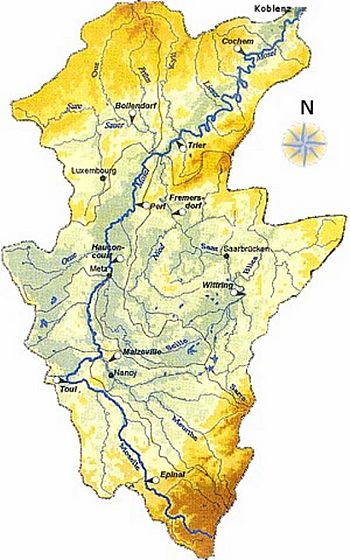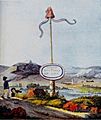Moselle River facts for kids
Quick facts for kids Moselle River |
|
|---|---|

The Moselle River
|
|
| Country | France, Germany, Luxembourg |
| Physical characteristics | |
| River mouth | Rhine 50°21′58″N 7°36′25″E / 50.36611°N 7.60694°E |
| Length | 545 km (339 mi) |
The Moselle River (German: Mosel) is an important river in Western Europe. It begins in the Vosges mountains in France and flows through Luxembourg before entering Germany. After traveling about 545 kilometers (339 miles), the Moselle joins the larger Rhine River in the city of Koblenz. This river has played a big role in the history and culture of the regions it passes through, especially with its famous vineyards and charming towns.
Contents
Where Does the Moselle Flow?
The Moselle River starts its journey in the Vosges mountains in northeastern France. As it flows, it creates a beautiful valley with many twists and turns. It then forms part of the border between Luxembourg and Germany for a short distance. Finally, it continues deep into Germany, where it meets the Rhine River.
Along its path, the Moselle passes by several important and historic cities. Some of these include:
- Metz in France, a city with a rich history.
- Thionville, also in France, known for its industrial past.
- Trier in Germany, which is one of Germany's oldest cities.
- Bernkastel-Kues, a picturesque town in Germany famous for its wine.
- Koblenz in Germany, where the Moselle proudly flows into the Rhine.
The Moselle's Famous Wine Region
The valley of the Moselle River is especially famous for its delicious wines. This area is one of Germany's 13 official wine regions and is known for its steep vineyards. The climate here is perfect for growing certain types of grapes.
The most well-known grape varieties grown along the Moselle include:
- Elbling: One of the oldest grape varieties in Europe.
- Riesling: This is the most famous grape of the Moselle, known for producing crisp, fruity white wines.
- Müller-Thurgau: Another popular grape that makes lighter, aromatic wines.
The wine-growing region is officially called Moselle-Saar-Ruwer. It gets this name because the Moselle River and its two main tributaries, the Saar and the Ruwer, all have vineyards along their banks. Many people visit the Moselle valley each year to enjoy the scenery, explore the vineyards, and taste the local wines.
Rivers Joining the Moselle
Many smaller rivers and streams flow into the Moselle River along its long journey. These are called tributaries. They add water to the Moselle and help form its wider river basin.
Tributaries from the Left Bank
As you look downstream (in the direction the river flows), these rivers join the Moselle from the left side:
- Madon
- Terrouin
- Esch
- Rupt de Mad
- Orne
- Fensch
- Gander
- Syre
- Sauer
- Kyll
- Salm
- Lieser
- Alf
- Endert
- Brohlbach
- Elz
Tributaries from the Right Bank
These rivers join the Moselle from the right side:
- Moselotte
- Vologne
- Meurthe
- Seille
- Saar
- Olewiger Bach
- Avelsbach
- Ruwer
- Feller Bach
- Dhron
- Ahringsbach
- Kautenbach
- Lützbach
- Flaumbach
- Altlayer Bach
- Baybach
- Ehrbach
Images for kids
-
The Moselle valley from the Roscheider Hof Open Air Museum, Konz, Germany
-
The Moselle at Trier, Germany
-
The Moselle near Cochem, Germany
-
The Moselle at Cochem, Germany
-
Confluence of the Moselle (right) and Rhine (left) rivers at the Deutsches Eck in Koblenz
-
High water marks in the Old Town of Cochem
-
Arm of the Moselle entering the old town quarter of Metz
-
Moselle river flowing through Metz, with the church of Temple Neuf
-
Cochem Castle, overlooking the Mosel
-
A liberty pole erected by the Moselle during the French Revolution, water colour by Goethe, 1793
See also
 In Spanish: Río Mosela para niños
In Spanish: Río Mosela para niños
















